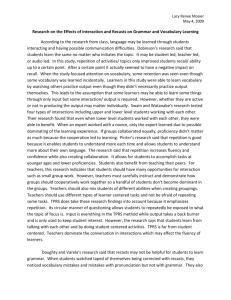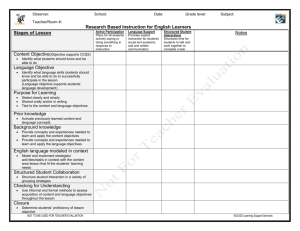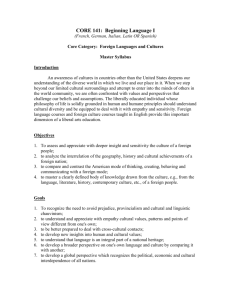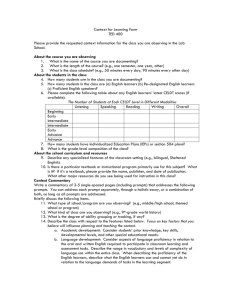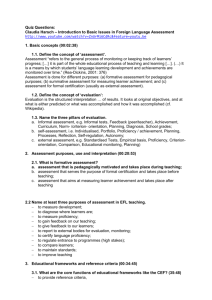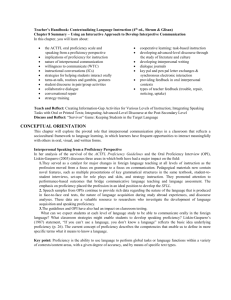TH_Chap_8 AnswerKey -
advertisement
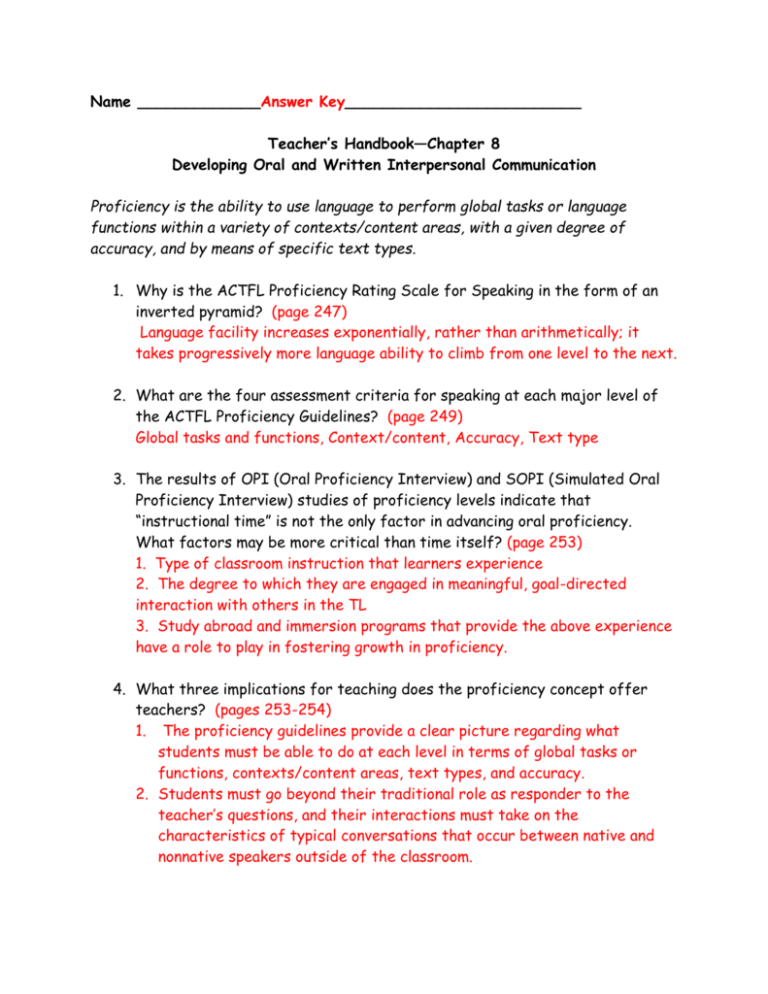
Name _____________Answer Key_________________________ Teacher’s Handbook—Chapter 8 Developing Oral and Written Interpersonal Communication Proficiency is the ability to use language to perform global tasks or language functions within a variety of contexts/content areas, with a given degree of accuracy, and by means of specific text types. 1. Why is the ACTFL Proficiency Rating Scale for Speaking in the form of an inverted pyramid? (page 247) Language facility increases exponentially, rather than arithmetically; it takes progressively more language ability to climb from one level to the next. 2. What are the four assessment criteria for speaking at each major level of the ACTFL Proficiency Guidelines? (page 249) Global tasks and functions, Context/content, Accuracy, Text type 3. The results of OPI (Oral Proficiency Interview) and SOPI (Simulated Oral Proficiency Interview) studies of proficiency levels indicate that “instructional time” is not the only factor in advancing oral proficiency. What factors may be more critical than time itself? (page 253) 1. Type of classroom instruction that learners experience 2. The degree to which they are engaged in meaningful, goal-directed interaction with others in the TL 3. Study abroad and immersion programs that provide the above experience have a role to play in fostering growth in proficiency. 4. What three implications for teaching does the proficiency concept offer teachers? (pages 253-254) 1. The proficiency guidelines provide a clear picture regarding what students must be able to do at each level in terms of global tasks or functions, contexts/content areas, text types, and accuracy. 2. Students must go beyond their traditional role as responder to the teacher’s questions, and their interactions must take on the characteristics of typical conversations that occur between native and nonnative speakers outside of the classroom. 3. The need to provide opportunities for students to hear a great deal of comprehensible and authentic language, to use the language in meaningful interaction with others, to negotiate meaning in cooperation with others, and to participate in an environment that encourages and motivates selfexpression in a nonthreatening way. 5. Describe the six characteristics of oral communication that make it “interpersonal”. (pages 254-255) 1. Two or more speakers are engaged in conversation and exchange information either a face-to-face discussion or a phone conversation 2. Interpersonal communication is meaningful and has as its objective a communicative task or reason for communicating. 3. There is usually an “information gap”; that is, one speaker seeks to acquire information that the other speaker has. 4. Interpersonal communication is spontaneous, partners must listen and interpret what the other speaker says. 5. It is necessary to negotiate meaning with one another in order to interpret meaning. 6. The use of gestures to make their message clear and to circumlocute. 6. What implications does the Willingness to Communicate (WTC) have for you as a classroom teacher? How does what you learned about motivation in Chapter 1 relate to WTC? (pages 255-257) Teachers should become familiar with the personality types of their students, their levels of anxiety about speaking the L2 with others, and how they interact with peers. This information can be used to structure experiences for the learners. Motivation from Chapter 1 (pages 31-34) 7. Teachers use “instructional conversations” (ICs) as a way to facilitate a conversation with students on a topic or theme that is interesting to them and intellectually challenging, while providing them with assisted performance. What are some examples of ways you can effectively use ICs in your classroom? Give at least 3 examples. (page 259) Engage students in ”warm-up” discussion of a personalized topic of interest Lead a discussion as learners interpret an authentic oral, printed, or video text Spark a discussion or the creation of a story based on a visual or cultural artifact Elicit opinions about a topic of high interest to learners Acquire new information with learners on a content-based or cultural theme Explore with learners the relationship among specific products, practices, and perspectives in C2 Guide learners through the process of designing a presentation or creating a product for an audience. 8. What does research on “routines and gambits” imply (two implications) for foreign language teachers? (pages 260-261) 1. Students incorporate gambits into their speech if they receive direct training and practice in gambit use. 2. Natural conversations are an effective context for eliciting gambit use. After looking at Appendix 8.4 on the TH Web site, list the 5 categories of common Spanish gambits. (These will be applicable to other languages.) 1. Openers 2. Keeping the Floor 3. Linking 4. Reactive Listening 5. Business Situations with a Stranger How could you teach “gambits” to your students? 9. In what specific ways can “gestures” help your students mediate between themselves and the world? (pages 261-262) Refer to lexical items (iconic gestures) Illustrate concepts (metaphoric gestures) To indicate images (illustrators) Point out objects in the immediate environment and virtual or far-off contexts and thus indicate space and time (deictic gestures) What kinds of “cultural” gestures for your target language do you feel are important for your students to know? 10. After reading the studies on repair in pair/group interactions, what are 3 important implications for you as a language teacher? (page 265) 1. Repair is possible only when students have opportunities for meaningful interaction in the classroom. 2. Repair is evidence of students becoming self-regulated in the language 3. Long turns at talk provide many opportunities for use of self-initiated, self-repair strategies. 11. “Task-based instruction enables students to interact with others by using the TL as a means to an end. In cooperative learning tasks, students work in pairs or small groups to help one another complete a given task, attain a goal, converse, or learn subject matter.” How does cooperative learning and taskbased instruction support 21st Century and post-secondary and workforce readiness skills? (See the Colorado Academic World Language Standards— “21st Century Skills and Readiness Competencies in World Languages”.) (pages 22-23) Critical thinking and reasoning Information literacy Collaboration Self-direction Invention 12. “Your family has just arrived in (a target language city). Everyone is trying to find their suitcases on the carousel and you get separated from your family. Find a policeman or airport agent to help you find your family.” Create a sequence of 3 interrelated tasks to help your students prepare and scaffold prior to engaging them in this culminating real-world task. (Reference pages 266-275 and related on-line chapter resources.) 13. Briefly discuss what you learned after reading the section “Developing Interpersonal Speaking Through Study of Literature and Culture”. (pages 276-279) 14. Which of these strategies for teaching interpersonal writing would you most likely use in your classroom and why: dialogue journals, pen pal/key pal letter exchanges, or synchronous electronic interaction? (pages 279-283) 15. Six types of teacher feedback in oral interpersonal contexts were identified in this section: explicit correction, recast, clarification request, metalinguistic feedback, elicitation, and repetition. In a study, teachers used __recasts_____ more than any other strategy for correcting errors. Interestingly, ___recasts______ was the strategy that proved least likely to lead to uptake. The most effective strategy with respect to uptake was __elicitation___. Figure 8.13 (page 286) illustrates six key findings of current recast research together with the implications for using recasts in foreign language classrooms. After reading the implications, when could recasts have a place in your classroom? (page 286) Make recasts less ambiguous In content-based classes, teachers should allow more time for learners to demonstrate uptake Reserve the use of recasts for older students who have more metalinguistic knowledge and a higher proficiency level Provide recasts for linguistic forms that learners have the ability to notice and correct Keep recasts short, declarative, focused primarily on pronunciation or vocabulary Provide recasts along with negotiation of meaning.
